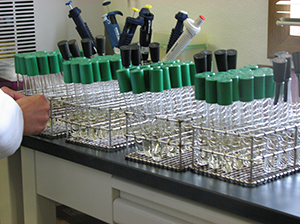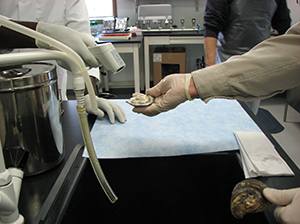Vibrio
What is Vibrio?
Vibrio parahaemolyticus (Vp) occurs naturally in marine environments. It is not related to pollution, which means that traditional controls for shellfish sanitation related to growing water classification are not effective to protect against the occurrence of Vp illnesses from shellfish consumption. Vp illness may self-resolve or lead to hospitalization.
Vibrio vulnificus (Vv) also occurs in marine environments and like Vp, illness may result from shellfish consumption. Vv illness, though not as common on Vp, tends to be more severe. The mortality rate from a Vv illness resulting from shellfish consumption is approximately 50 percent in healthy people. The rate is 70 percent in people with certain underlying conditions such as liver disease. If not treated within 72 hours of infection, septicemia can occur and death may be likely.
 What does New Jersey do to address Vibrio in shellfish?
What does New Jersey do to address Vibrio in shellfish?
New Jersey’s Vibrio Control Plan (VCP) addresses program coordination, response to potential outbreak, post-harvest time and temperature controls, hours of harvest for tidal and intertidal aquaculture, and Hazard Analysis and Critical Control Points (HACCP) plan requirements. In addition, the VCP recommends additional best management practices to be implemented to further minimize risk from Vp and Vv.
Procedures for dealing with Vibrio have been developed over the past several years through the Interstate Shellfish Sanitation Conference and are part of the National Shellfish Sanitation Program’s Guide for the Control of Molluscan Shellfish. The requirements for the authority set forth in the Guide are accomplished through a coordinated effort of the Department of Environmental Protection and the Department of Health.
- 2025 – Vibrio Control Plan
- CDC – Vibrio
- Hazard Analysis and Critical Control Point (HACCP) is a management system in which food safety is addressed through the analysis and control of biological, chemical, and physical hazards from raw material production, procurement and handling, to manufacturing, distribution and consumption of the finished product.
As part of the annual Vibrio sampling program, the New Jersey Department of Environmental Protection (NJDEP) collects oyster tissue, sediment, and water samples between the months of June and August. These samples are analyzed for total Vp, the virulent genes of Vp (trh and tdh), and Vv, using Polymerase Chain Reaction. Strain identification is also performed using Pulsed-Field Gel Electrophoresis (PFGE) to determine what virulent strains of Vp are in NJ waters.
 OFFICIAL SITE OF THE STATE OF NEW JERSEY
OFFICIAL SITE OF THE STATE OF NEW JERSEY
